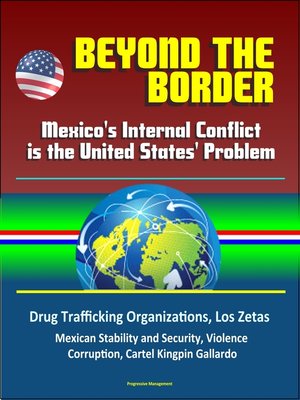Beyond the Border
ebook ∣ Mexico's Internal Conflict is the United States' Problem--Drug Trafficking Organizations, Los Zetas, Mexican Stability and Security, Violence, Corruption, Cartel Kingpin Gallardo
By Progressive Management

Sign up to save your library
With an OverDrive account, you can save your favorite libraries for at-a-glance information about availability. Find out more about OverDrive accounts.
Find this title in Libby, the library reading app by OverDrive.



Search for a digital library with this title
Title found at these libraries:
| Library Name | Distance |
|---|---|
| Loading... |
Professionally converted for accurate flowing-text e-book format reproduction, this unique case study provides a starting point to address the importance of strategic guidance as it relates to operational planning for synchronized tactical actions. Analyzing Mexico's drug-war offers an interesting case study to help understand the current situation surrounding non-traditional forms of war, such as a drug related war, and how Mexico's internal conflict impacts their regional neighbors as well as the international community. The ultimate aim is to achieve a competent level of understanding in order to establish a unified regional approach that will disrupt the Mexican drug trafficking organizations and reduce violence to an acceptable and controllable level. Accomplishing this requires the unified efforts of all elements of national power from the U.S., Mexican, and regional governments by designing an operational approach that focuses efforts and unifies goals. The current U.S. and Mexican strategies work to contain drug trafficking organizations on a limited basis, but fail to fix the problem for the long-term because of their limited approach. At the conclusion, this study reveals how the employment of unified governmental approach can enhance the United States and Mexico's current security strategy by disrupting the actions of the Mexican drug trafficking organizations.
INTRODUCTION * 1. UNDERSTANDING THE CURRENT SITUATION * Rise of Drug Trafficking Organizations in Mexico * Causes and Costs of Instability in Mexico * 2. DEVELOPING AN UNDERSTANDING OF THE STRATEGIC APPROACH * United States' Strategic Vision to Achieve Security and Stability in Mexico * Mexico's Strategic Vision for Security and Stability within their Borders * The International Community's Strategy for Security and Stability in the Western Hemisphere * 3. LINKING STRATEGY TO TACTICS: THE CURRENT OPERATIONAL APPROACH * CONCLUSION
The security of the U.S.-Mexican border is a growing concern for both countries, especially since their economic relationship has grown more interdependent over recent years. The North American Free Trade Agreement (NAFTA), manufacturing plants, and labor ties between the U.S. and Mexico have strengthened their economic interdependency over the last several decades. Mexican DTOs have taken advantage of established U.S.-Mexican policy protected trade routes created by those same economic opportunities, allowing them to feed off of American illegal drug users. Competition over the illegal narcotics market has resulted in increased violence in society, intimidation of the citizenry, and extensive coercion throughout the Mexican governance and law enforcement agencies. The Mexican government's inability to subdue drug trafficking cartels has destabilized Mexico, thus creating spillover effects into the U.S.







